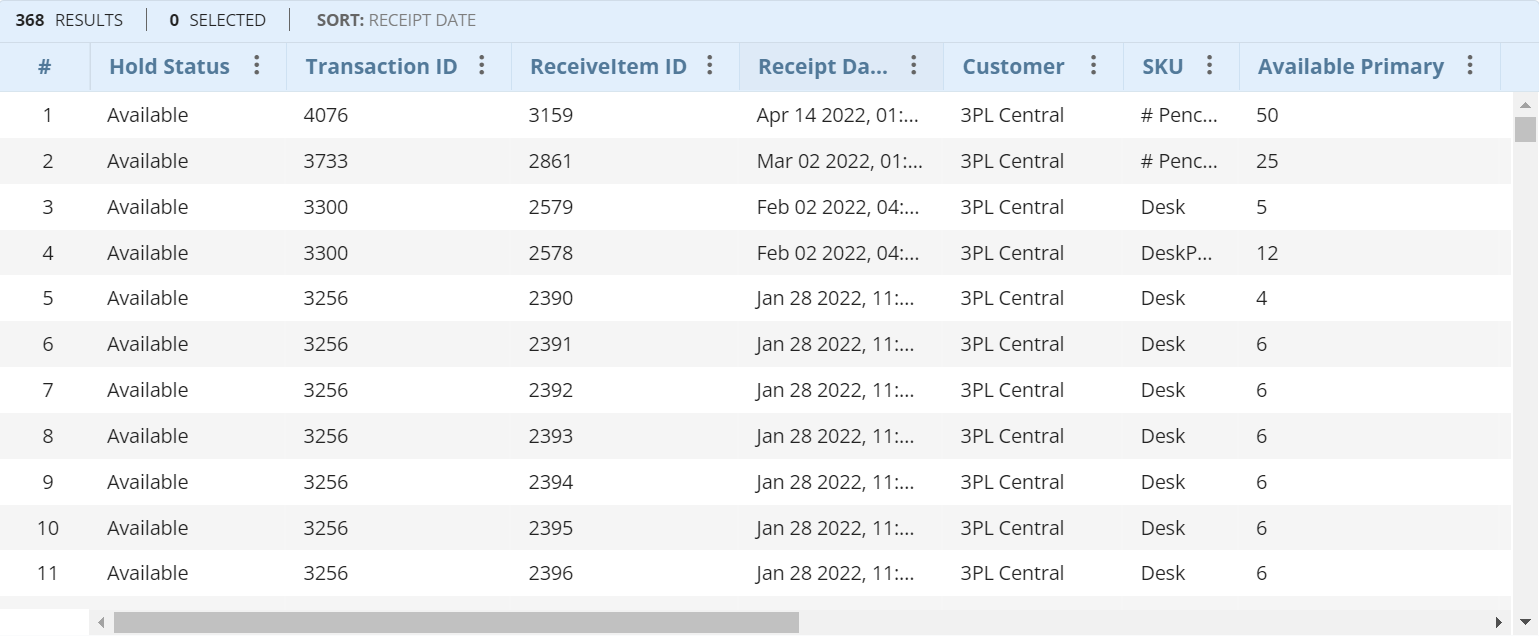With the rise of ecommerce and increased competition in the third-party logistics (3PL) industry, more and more 3PLs are looking for ways to track, benchmark, and improve their business performance. Implementing policies and procedures that allow for the tracking of specific aspects of storage, fulfillment, and more can be complex and challenging. Many turn to software to help them get a handle on their warehouse performance, but still struggle to understand which metrics are most important and how to interpret them. Below are nine useful key performance indicators (KPIs) for 3PLs to start tracking to gain insight into top-performing and improvement-needed areas.
Inventory
Inventory tracking metrics can be an indicator of efficiency in a variety of areas. Are your employees entering inventory data into the warehouse management system (WMS) as they should be? Are you able to give your customers enough notice of low inventory levels? Do you have enough staff to manage that level of inventory successfully? How much is this inventory costing you? Are you over- or under-committing? Using a WMS to accurately track your inventory levels can also lead to more accurate financial forecasts, location planning, and operations management.
1. Inventory Accuracy
Inventory accuracy can be a great place to start before attempting to track a variety of inventory control KPIs. Inventory accuracy rate = (Counted units/Units on record) x 100. Start with your warehouse management system – from here, it should be easy to see how many units you have on record. In Extensiv 3PL Warehouse Manager, inventory levels can be viewed from the Manage Inventory page. As you can see, the available number of items is listed in the Available Primary column on the righthand side of this screen.

Next, perform a physical count. You can use the Audit Inventory function to compare and then reconcile your physically counted items with the items accounted for in the WMS. Before you reconcile, however, make sure you have a record of the physically counted items to perform the calculation. You can then use this rate to benchmark against yourself in the future (on a quarterly or annual basis, perhaps) and track improvements. Industry best practices recommend that you should strive for an accuracy rate of 95% or more.
2. Carrying Cost per Unit
Carrying cost refers to the amount spent to stock and store inventory before shipment. Carrying costs can refer to things like storage, labor, transportation, handling, insurance, taxes, replacement, shrinkage, and depreciation. To calculate carrying costs, simply add together the costs of storing and holding that inventory. Allocating expenses to inventory can vary by business needs and objectives but can be invaluable in performing this kind of analysis. These can be significant costs to 3PLs, and it’s important to track them to gauge the efficiency of your putaway, storage, and inventory management procedures, as well as the profitability of specific customer accounts. If carrying costs overall are too high, this can put your business’s cash flow at risk.
3. Inventory Turnover Rate
Inventory turnover rate can also help you assess your customer profitability. Especially once you have calculated your carrying cost per unit, monitoring inventory turnover is another way to get an idea of exactly how much the product sitting in your warehouse is costing you and if your policies around storing inventory are working for you. The goal is to increase your inventory turnover rate over time. You can use the carrying cost calculation to get started. Then, if you’ve been tracking your inventory accuracy over time (say, one year) you can determine the average inventory for the period you’re interested in. This will help you get a clear picture even if you’ve had one unusually busy or slow month. Inventory turnover ratio = Cost to carry inventory/Average inventory in the period.
4. Shrinkage
Finally, shrinkage is an unfortunate but necessary aspect of inventory KPI monitoring. Shrinkage, in addition to theft, can also include damaged items, lost items, unsellable items, or other losses due to unforeseen circumstances. Calculating shrinkage, however, is only the first step. It’s important to identify the source, determine if the problem can be rectified, and identify a plan of action. Some shrinkage may be unavoidable, and many businesses expect a usual rate of shrinkage based on experience. The best-case scenario, however, is that shrinkage highlights a broken or inefficient process in the warehouse and lets management know that it needs to be fixed. If you start seeing escalating or higher than normal shrinkage rates over time, that’s a cue to investigate further. Shrinkage = (Carrying cost of recorded inventory – Carrying cost of physical inventory)/Carrying cost of recorded inventory.
Fulfillment
Fulfillment KPIs often focus heavily on efficiency and profitability. As most 3PLs probably know, efficiency and probability are closely linked. Measuring fulfillment- related KPIs can help you understand how long the process is taking and where you may be leaving money on the table.
5. Average Lead Time
Fulfillment lead time refers to the length of time it takes the end-consumer to receive a product after it’s been ordered. This lead time can be dramatically shortened by the integration of ecommerce shopping carts with your WMS. From that point, it is important to process orders as quickly as possible, so that the end consumer can receive them with minimal delay. Lead time can be an indicator of customer satisfaction, as well as efficiency of your processes and management of inventory. If this metric is positive, this may even be a selling point to future customers. If it’s not positive, it may be an indicator that your warehouse processes are inefficient and could eventually cause you to lose business.
6. Cost per Unit Shipped
Like carrying costs, adding up all the costs associated with fulfilling and shipping a product can give insight into efficiency of processes and give you an idea of the profitability of your operations. Shipping costs include all picking, packing, and shipping costs, including labor. Again, the costs and how it makes sense to allocate them per unit shipped will vary by warehouse, but the benefits of accurately measuring the cost of your primary warehouse activity can give managers powerful insight.
7. On-Time Delivery
On-time delivery can be as simple as it sounds. Track the number of orders delivered on time or early from your warehouse. This is especially important for warehouses participating in ecommerce fulfillment where timely delivery is paramount. Next, you can turn this into a ratio or percentage to make interpretation easy for a wide variety of stakeholders. On-Time Delivery = Number of units delivered on time/Number of units shipped. Again, if this metric is positive, tracking it can aid in the acquisition of new business. If not, it’s an indicator that you’ll need to tighten up processes in the warehouse to meet customer expectations.
Picking and Packing
Measuring picking and packing performance KPIs can help you gauge the productivity of your staff, the accuracy of your deliveries, and the satisfaction of your customers. There are many KPIs applicable here that can be flexible enough to apply to other warehouse operations as well, such as receiving and putaway. Here, we will discuss picking and packing, but think about where else in your warehouse these metrics might help you pinpoint weak spots and expand on processes that work.
8. Picking Accuracy
Picking accuracy is essential to successful order fulfillment. If picking is inaccurate, it can greatly slow down the process, resulting in a negative change in all other metrics discussed thus far. In addition, consistent picking inaccuracy can have a negative impact on consumer satisfaction and word of mouth. Particularly for ecommerce customers for whom consumer satisfaction is a high priority, 3PL warehouses should measure their picking accuracy and use it as a selling point if they have a successful track record. Order Picking Accuracy = Error-free Orders/Total Orders. Perfect order rate is another KPI in itself that can be useful to track–this measures how many orders have been shipped without incident (incident meaning damaged goods, inaccurate orders, or late receipt).
9. Rate of Mis-ships
Closely linked to picking accuracy is rate of mis-shipped, measuring how many orders have been shipped incorrectly or in poor condition. As such, this can influence favor or disfavor with clients, depending on how well you track this KPI and what the results are. You can even segment by cause for return to drill down further into areas that need improvement. Rate of mis-ships = Number of mis-shipped units/Number of units shipped.
Of course, there are many more metrics out there specific to warehouse size, capacity, and industry vertical that 3PLs can use to track virtually any area of their business’s performance. To learn more about the most popular KPIs 3PLs are tracking this year, check out our 2021 Third-Party Logistics Benchmark Report.
-
You’ll read about:
Be the first to know
Subscribe to our newsletter





